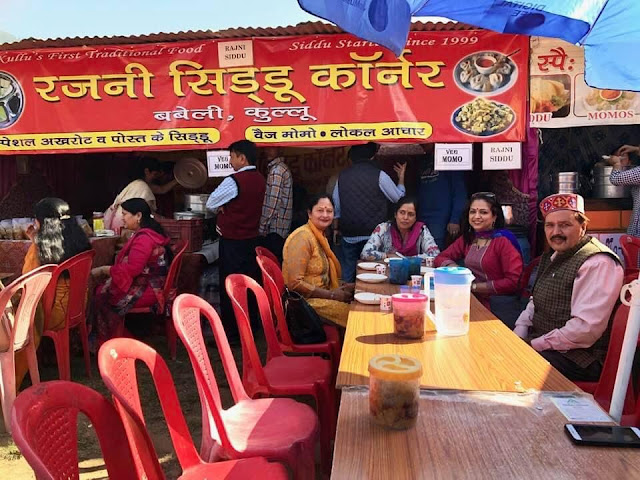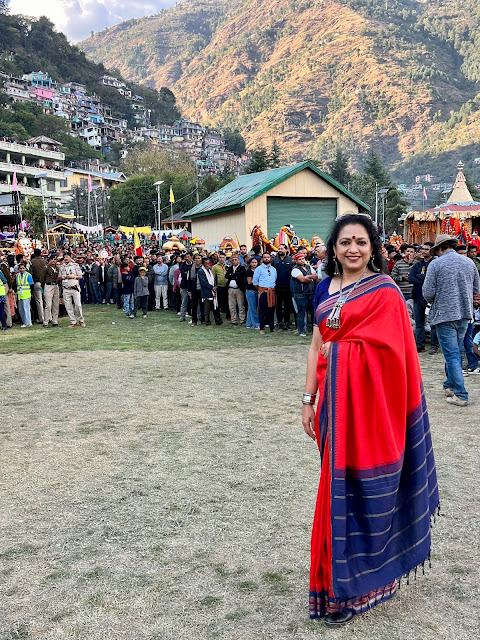KULLU DUSSEHRA - The connect between 'GOD and MAN'
Many
legends are related to Kullu Dussehra – the story of Raja Jagat
Singh and of Jamdagini rishi and ‘Tarah Kardu ki Sauh’ (a basket made of
Bamboo and eighteen deities) – are the accepted ones. I shall, however,
narrate the popular folklore here.
The Raja was so overwhelmed by the divine power of lord Raghunathji that he abdicated his throne for the Lord and became his 'chharibardar' (regent). He then invited all the local Devi and Devtas on the Vijayadashmi day to pay their obeisance to the new Lord of Kullu, accept his suzerainty and celebrate together. It is said that the Raja perhaps wanted this celebration to seek penance for his sins as well. This was the starting of Dussehra in Kullu.
This was an important move on the part of Raja as Himachal has a strong culture of ‘Local Deities’ which are mainly the form of Shiva and Shakti. Local deities are obeyed by all and are present in the daily lives of their devotees - guiding, commanding and counselling them. The fragrance associated with Sita and Rama, Radha and Krishna is almost absent in Himachal.
Hence,
the acceptance of Raghunathji by local deities was important and he became the
main deity of Kullu valley and Dussehra festival with Himachali influence in
his Puja (worship) and Shringaar (decorations).
.jpg)
I will divide Kullu Dussehra into three main attractions as according to one’s interest and passion. The Rath-Yatra; the Devi and Devta’s; the Fair and Cultural programs.
All roads leading to the Kullu city are full of processions of beautifully adorned wooden palanquins of Devtas and they being worshipped by the locals. They first go to Raghunathji’s temple and then some join the rath-yatra and some directly to their designated sitting areas in the Mela ground.
The Devtas on their way to meet Raghunathji and to the Mela ground
The beautifully adorned Mela ground starts getting filled up with umpteen numbers of devotees and tourists. The music created by the beating dhols, Ranasingha, Thonkru add to the atmosphere along with continuous chanting of ‘Jai Sri Ram’. The entire atmosphere gets charged.
I had planned to sit in the stall and watch, but could not stop myself from going near the Devtas for the feel. To be amidst the vibrations was enigmatic.
The Rath of Raghunath ji
Raghunathji and Sita Mata are adorned with flowers and are brought to the ‘Upper Maidan’ from their temple by their priests and Raja of Kullu and placed on the most extravagant ‘Rath’ which is tied by the 'hemp ropes'. Each person present wait for the moment the Rath shall be pulled by hundreds (considered to be extremely auspicious) and the yatra shall commence. Many other Devi and Devtas also join in and take their historically designated positions. They greet each other and also do ‘Khela’ (some rituals ). The yatra commences after Devi Hadimba – one of the most important deity - permits it.
 Raghunathji arriving at the Mela Ground
Raghunathji arriving at the Mela Ground
As the time for pulling the ropes neared, I could
feel the vibrations - thousands of eyes were only on the main Rath. As if nothing was more important in life at that moment. We
all watched in awe when the ropes were pulled and the ‘Rath’ of
Raghunathji and other Devtas slowly started marching towards the lower
Mela ground. It lasted few minutes only, but was indeed a divine and
mesmerising sight to be experienced at least once in life. What is also commendable was the disciplne shown by the devotees - present in lakhs. The drone shot of Yatra - courtsey DC Kullu
The drone shot of Yatra - courtsey DC Kullu 
 The entire Yatra - Mela ground - Drone shot - DC office
The entire Yatra - Mela ground - Drone shot - DC office
The Devi and The Devta’s of Kullu Valley –
For me the most fascinating experience of Kullu Dussehra was to getting to know about the 'Devta culture' and seek blessings from all 300 plus Devtas sitting in their pre designated place allocated in the Mela ground since ages. The feeling of being able to do so is unexplainable.
What also intrigues me is that the Devtas of Himachal (including Kullu) are living and moving entities. Most of the temples do not have fixed statutes; they have Raths with Devtas placed on them. The Devtas mounted on Raths come in and out of their temples and also go into people’s homes at their will. They follow a set pattern of rituals which are quite complex to be explained here, but what I understood in brief was that each Devta has designated families to look after them and set rules for their management.
The hierarchy amongst the Devtas is clearly defined. Raghunath ji and his regent are at the top and rest are as according to faith shown by their devotees for them in numbers and income. Interestingly only the Devtas of Kullu valley participate in Dussehra and not of neighbouring districts.

Mela ground - 2023 The visit to the Mela is not complete if one doesn't eat Siddu at Rajni's stall - the best Siddu I have ever eaten
The visit to the Mela is not complete if one doesn't eat Siddu at Rajni's stall - the best Siddu I have ever eaten
On the last day of the Mela some animals are
sacrificed and a huge bonfire is lit to signify the burning of Lanka – a custom
probably added much later. The idol of Lord Raghunathji is brought back to its
temple in Sultanpuri through a grand procession know as "Lugari" which is also a grand feast. The rest of Devtas also go
back to their places of origin. The end of Dusshera also is the time of the
closing of many temples for winters and they re-open around Shivratri.
For me Kullu Dussehra was meaningful and full
of divinity, but what fascinated me the most was how the entire populace of the
valley immerses itself into the divine atmosphere of Dussehra festivities for
seven days as if the gates of heaven have been opened and the Gods have descended
to the valley. The people living in the city get to connect with their villages
through their Devtas. I could see
traditional attires and Kulluvi Topi everywhere - even on young heads. It was
endearing and reassuring that all - especially younger generation - is
connected to its roots and traditions and cherish them in totality.
JAI RAGHUNATH JI KI



















.JPG)













सारगर्भित आलेख और संस्मरण,,,,,
ReplyDeleteVery informative, madam
ReplyDeleteYou have written so well and also supported with beautiful photographs to let us feel as if we are ourself in the Dashehra festival.
Very good pics and very comprehensive blog .
ReplyDeleteThe ambience of Kullu Dussehra Grounds is heavenly and unique
Just read your article on the Kullu Dussehra. Very interesting reading. Very informative. The description is vivid that I felt
ReplyDeleteWell summarized, exquisite pictures and the elegance all around is just overwhelming. THANKS FOR SHARING.
ReplyDeleteBeautifully penned with indepth narrative. Makes for an Awesome read indeed!
ReplyDeleteBeautifully penned. Makes up for an awesome read indeed!
ReplyDeleteVery informative and beautiful collection of pictures. Great work mam.
ReplyDeleteIt felt like being amidst Kullu Dussehra while reading your write-up. Ma'am, my compliments and congratulations to you for this beautiful blog.
ReplyDeleteMa'am you are looking gorgeous as usual.. beautifully penned...very informative maamy
ReplyDeleteVery informative and unique collection ma'am 🙏
ReplyDeleteAnu sent you a message on your what’s app. Far too long for a comment here. Absolutely fascinating
ReplyDeleteVery informative
ReplyDeleteSuch a fine description. Eagerly waiting to attend the Dusshera someday!
ReplyDeleteSuch a detailed explanation of the finer nuances. I enjoy reading all your writings and getting to know more about Himachal . I look forward to a book published soon. Keep up the excellent work.
ReplyDelete……….and ‘Prasad’ in the Kullu valley is always chunks of meat. So I discovered. Unique indeed
ReplyDeleteThanks for this information - I was not aware - will try to find out more.
Delete